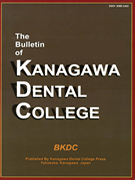- HOME
- > 一般の方
- > バックナンバー:The Bulletin of Kanagawa Dental College
- > 28巻1号
- > アブストラクト
アブストラクト(28巻1号:The Bulletin of Kanagawa Dental College)

English
| Title : | A Multivariate Analysis for Classification of Craniofacial Morphology in Facial Asymmetry |
|---|---|
| Subtitle : | ORIGINAL ARTICLES |
| Authors : | Fumiko Tsurumi*1, Hirofumi Takagi*2, Kenji Fushima*1 |
| Authors(kana) : | |
| Organization : | *1Department of Orthodontics, Kanagawa Dental College, *2College of Biomedical Technology of Niigata University |
| Journal : | The Bulletin of Kanagawa Dental College |
| Volume : | 28 |
| Number : | 1 |
| Page : | 15-27 |
| Year/Month : | 2000 / 3 |
| Article : | Original article |
| Publisher : | Kanagawa Odontological Society |
| Abstract : | [Abstract] Morphological features of 205 subjects with facial asymmetry were investigated by means of postero-anterior (PA) and lateral cephalograms. Multivariate principal component analysis was applied to classify the facial asymmetry into subdivisions. Three factors were considered in this study. These were antero-posterior position and size of the mandible (factor-1), facial asymmetry (factor-2) and overjet as well as the tooth axis of the lower incisor (factor-3). Based on these three factors, facial asymmetry was further classified into eight types, For the PA cephalogram, each group was characterized mainly by its mandibular asymmetry, especially mandibular lateral displacement. The skeletal characteristics showed that the ramus height was smaller, the facial width at the gonion level was larger and a greater infero-lateral inclination of the lateral border of the ramus was found on the mandibular displaced side than on the opposite side. The dental characteristics were of a frontal occlusal plane ascending toward the mandibular displaced side and a lower dental midline displaced along with a mandibular skeletal displacement, while the lower incisors tended to incline toward the opposite side. For the lateral cephalogram, it was demonstrated that facial asymmetry was a morphological characteristic found not only in a mandibular prognathism but also in other various skeletal types, for instance in a mandibular retrognathism. Thus, in patients with facial asymmetry, the treatment plan should be based on the individual skeletal type. |
| Practice : | Dentistry |
| Keywords : | Facial asymmetry, Principal component analysis, Cephalogram, Mandibular lateral displacement |
